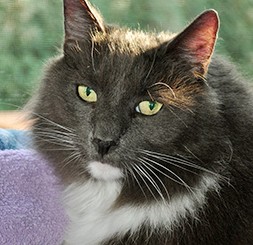Overview
Cherry eye is a disorder of the third eyelid, which is located in the inside corner of each eye. The third eyelid is a membranous structure that contains glands; normally, you aren’t able to see it. With cherry eye, this third eyelid shifts out of its normal position and becomes swollen and inflamed, resembling a cherry—hence the name.
Certain flat–faced breeds, such as Burmese, Himalayans, and Persians, are predisposed to this condition, which is less common in the cat than it is in the dog.
 So what causes this eye sore (literally!)? While it is considered a hereditary condition, the exact role that genetics play is unclear. In some cases, it may develop secondarily to inflammation, but in many cases, the cause is unknown.
So what causes this eye sore (literally!)? While it is considered a hereditary condition, the exact role that genetics play is unclear. In some cases, it may develop secondarily to inflammation, but in many cases, the cause is unknown.
Symptoms
In most cases, cherry eye is an easy condition to spot. A pinkish–red, round, cherry–like mass will protrude from the inside corner of your cat’s eye. Her eye might also look red or inflamed, glassy, watery, or you may notice mucus or a pus-like discharge from the eye. Also, your cat might be pawing at the affected eye.
Diagnosis/Treatment
Your veterinarian will most likely perform a complete eye exam to determine if there are other existing conditions or to find an underlying cause. These may include measuring your cat’s tear production levels and a test to rule out corneal ulceration and other eye problems.
Unfortunately, medications rarely help the prolapsed third eyelid move back into its normal position, so surgery is often recommended. Surgery, which usually consists of suturing the prolapsed structure back into place, has a very high success rate. Because the third eyelid is responsible for producing one-third of your cat’s tears, removing it is usually a last option as your cat would likely require eye drops to help keep the eye moist thereafter.
If your pet requires surgery, your veterinarian may also recommend preanesthetic blood tests to ensure that your cat is healthy and can tolerate the anesthetic procedure. These may include:
- Chemistry tests to evaluate kidney, liver, and pancreatic function, as well as sugar levels
- A complete blood count to rule out blood-related conditions
- Electrolyte tests to ensure your cat isn’t dehydrated or suffering from an electrolyte imbalance
Often, eye drops or ointments are prescribed either prior to and/or after surgery. If your feline compadre pooh-poohs the idea of eye drops, watch an expert apply eye drops to a cat—you'll pick up some pointers that may help you. Your veterinarian may also provide an Elizabethan collar to prevent your friend from scratching at her eyes after surgery.
Prevention
Since the cause of cherry eye is almost always unknown, it is difficult to identify ways to prevent this condition. To help your pet reduce the risk of eye problems, check her eyes daily for any obvious signs of irritation, such as redness or tearing. Above all, contact your veterinarian if you suspect your best friend’s eyes look irritated or inflamed!
If you have any questions or concerns, you should always visit or call your veterinarian – they are your best resource to ensure the health and well-being of your pets.
